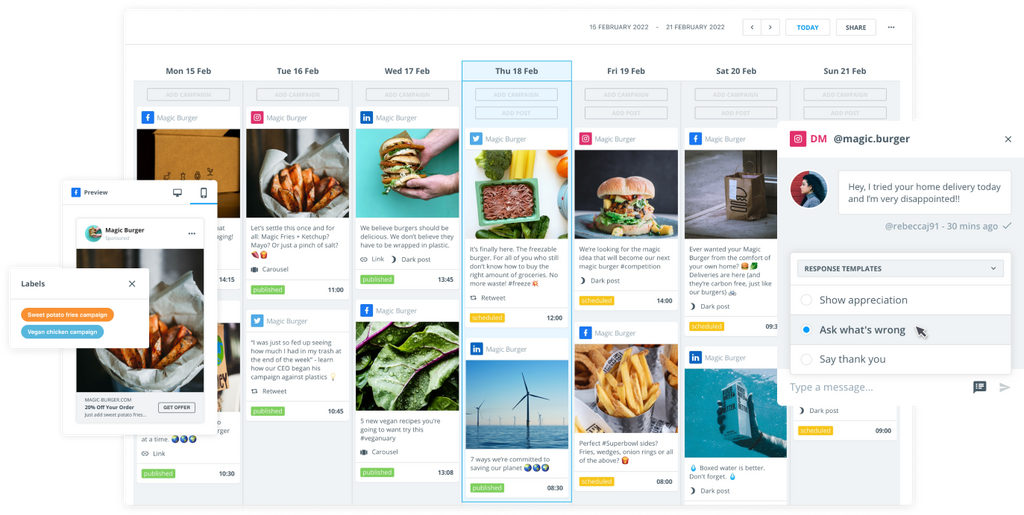What is CPM on Facebook?
CPM stands for cost per mille. This is the price you pay for 1,000 impressions on your Facebook ad.
Fun fact of the day: ‘mille’ means 1,000 in Latin.
You should optimize for CPM on Facebook if you’re looking to get your ad seen as much as possible. If you select this option, Facebook will get your ad in front of as many eyeballs as it can within your budget.
Why pay per 1,000 impressions instead of per individual impression?
Impressions are pretty cheap, so if you counted the cost of each one you’d be dealing with fractions of a cent—it’s just easier to multiply by 1,000.
What is CPV on Facebook?
CPV stands for cost per view. This is the price you pay for a view on your Facebook video ad.
You should optimize for CPV on Facebook if you want people to pay attention to your video content. With this option, Facebook will get as many views of a given duration as it can for your ad budget.
You’re probably wondering what actually counts as a view, right? If someone just looks at your video ad for one second and keeps scrolling, will your CPV take that into account?
Fortunately, no.
As of November 2016, Facebook has two separate ad cost metrics for video views: cost per 3-second video view and cost per 10-second video view.
So, you can either look at the price you paid for each view that lasted three seconds or longer or you can see how much you’re paying for views that last 10 seconds or longer.
What is CTR on Facebook?
CTR stands for click-through rate. This is the percentage of people who actually clicked on your ad after seeing it.
To calculate CTR on Facebook, divide the number of link clicks on your Facebook ad by the number of ad impressions (x 100% to get a percentage).
For example, if 100 people see your ad and 10 of them click on your link, then your CTR on Facebook would be (10 link clicks/100 impressions) x 100%, or a 10% click-through rate (which would be awesome).
Looking at your CTR is a great way to see how well your ad is performing, since it basically tells you how many users were interested enough your ad enough to actually click on it.
A low click-through rate on Facebook shows you that your ad was not very engaging to those who saw it.
A high click-through rate, meanwhile, probably indicates that the ad was really convincing.
What is CVR on Facebook?
CVR stands for conversion rate. This is the percentage of link clicks to your website that resulted in a conversion (a purchase, a webinar signup, or any other form of lead generation).
To calculate CVR, divide conversions from your Facebook ad by the total number of link clicks it received, then multiply by 100%.
So if you had 100 people click the link in your ad and 5 convert on your landing page, your conversion rate on Facebook would be (5 conversions/100 link clicks) x 100% = 5%.
Examining your CVR is excellent for determining the effectiveness of your landing page once people click your Facebook ad.
A low conversion rate means that few people who clicked on your ad actually completed your desired action.
A high conversion rate likely means your landing page did a great job of convincing people to buy your product, download your app, sign up for your email list, or take another action of your choice.
What is ROI on Facebook?
ROI stands for return on investment. This is the ratio of the amount of revenue you’re making through Facebook ads to the amount of money you put in.
Though this is one of the more basic concepts in digital marketing, actually calculating your Facebook ROI can be pretty complicated.
At its simplest, your Facebook ROI is (total revenue generated from user actions on your Facebook ads – your total ad spend) / total ad spend x 100%.
For example, if you spend $100 on a Facebook ad and it results in $200 of revenue from sales on your website, your ROI is ($200 sales revenue – $100 ad spend) / $100 ad spend x 100% = 100%.
100% ROI means your Facebook ads are doubling your money, essentially.
Of course, there are a lot more costs and factors to include in any real-world calculations, but that’s the basic idea.
A good rule to follow is that as long as your Facebook ROI is positive, you should keep investing more in ad spend until it stops making you a net profit.
Facebook from A to Z
These Facebook advertising acronyms are pretty useful to know in today’s increasingly complicated social media marketing environment, and they’re just the tip of the iceberg.
Regardless of whether you’re optimizing your CPM, your CPV, or your C-3PO (okay, fine, the last one is a Star Wars character), make sure your advertising objectives are clearly defined and you’ll see great ROI on your Facebook ads.
Get all the social tea in our Social Media Professionals group on LinkedIn.
